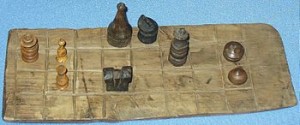To Vary Chess or Not To Vary Chess
It’s no secret that chess is a complex game. Many attendees of Crobs’ social chess meetings have played for years and quite a few members have clocked over a decade of experience at the chessboard yet none would claim mastery.
Despite the challenge chess poses for the average person, the Crobs’ team were surprised to discover the existence of over 2000 published variations, according to the estimate given by David Pritchard, author of The Encyclopaedia of Chess Variants.
“Chess is already complicated enough” – Vassily Ivanchuk, Ukrainian Chess Grandmaster
Known also as unorthodox chess, a chess variant is a game inspired by, or a derivative of chess. Chess variants diverge from conventional chess in one or more of these areas:
- Different rules for capture, move order, game objective
- Addition, substitution or removal of standard chess pieces
- Different chessboards, which may be larger, smaller or shaped differently
In chronological order, the following three variants illustrate these points of difference.
In Benedict Chess, capturing pieces is not permitted. For example, if a white bishop captures a black knight, that knight is removed and replaced with a white knight on the same square. The attacking bishop does not move.
Peasant’s Revolt was invented by Frey in 1947 and involves assigning White “the peasants” a king and eight pawns to battle Black “the nobles” who starts the game with a king, a pawn and four knights. Black has the obvious advantage, however if the inequality too great between the players, Black may play with three knights instead of four.
Created by George Dekle Sr, Masonic chess is played on a modified board where the even-numbered ranks are indented to the right to resemble masonry brickwork.
Retaining the essence of standard chess, the movement of the pieces however, has been adapted to the geometry of the playing surface.
Based on the sheer number of chess variants that exist, it’s impossible for us to cover them all in one blog, so we’ve decided to feature one per month for those interested in exploring alternative games. In May, we’ll feature one of the most known variants – Chess960 – invented by former world chess champion, Bobby Fischer.
As great as standard chess is, before dismissing chess variants, you may find it interesting to learn the game we currently play only exists because it itself is a variant. Once upon a time, the movement of the queen was limited to a “ferz” – a single square in a diagonal direction only.
Chris is keen to try a chess variant at a Sunday Crobs’ chess meeting. In particular, Doublewide Chess, which follows standard chess rules but involves connecting two regular chessboards for a 16 x 8 playing surface and assigning players two complete sets of chess pieces each. Any challengers?
Chris & the Crobs’ Chess Team



Comments are closed